Guide for hares
Didcot Hash Trail Markings
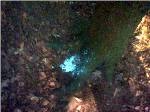 This is a BLOB! Three consecutive blobs indicate the correct trail is being followed.
This is a BLOB! Three consecutive blobs indicate the correct trail is being followed. This is a CHECK - used to indicate that the trail can go off in any direction. It is up to the hounds to find the correct trail marked with three blobs of flour from this point. Didcot hash usually require six hounds to reach the chek before any are permitted to start looking for the trail beyond this point.
This is a CHECK - used to indicate that the trail can go off in any direction. It is up to the hounds to find the correct trail marked with three blobs of flour from this point. Didcot hash usually require six hounds to reach the chek before any are permitted to start looking for the trail beyond this point.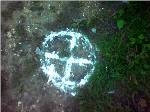 A special check - a REGROUP. Tells the pack that they should wait until ALL the hounds have arrived before any can move on.
A special check - a REGROUP. Tells the pack that they should wait until ALL the hounds have arrived before any can move on.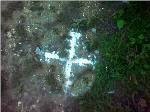 A FALSE TRAIL - indicates that the trail does not proceed beyond this point and hounds should not go beyond it.
A FALSE TRAIL - indicates that the trail does not proceed beyond this point and hounds should not go beyond it. An ARROW is used to show the correct direction of the trail - use it when the path may veer in unexpected directions and no check is wanted or to guide the hounds directly away / over hazards like roads without hesitation.
An ARROW is used to show the correct direction of the trail - use it when the path may veer in unexpected directions and no check is wanted or to guide the hounds directly away / over hazards like roads without hesitation.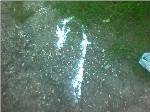 A FISH HOOK - the hound have been caught out! They should stop and back-track to find a 'devious' change of direction (sometimes a figure denotes the number of blobs of flour they have to back-track).
A FISH HOOK - the hound have been caught out! They should stop and back-track to find a 'devious' change of direction (sometimes a figure denotes the number of blobs of flour they have to back-track).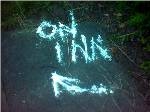 The ON INN - approx 400 yards before the pub - indicates that the end is nigh and a well earned drink awaits.
The ON INN - approx 400 yards before the pub - indicates that the end is nigh and a well earned drink awaits.The Hash Needs Hares
 The hash survives from week to week as a result of everybody taking his or her turn to be a hare and lay a trail. It is a real challenge to research and lay a good trail with the aim of outwitting the pack of walkers / runners - the hounds. It can then be very satisfying to watch them find their way around your trail. The overall aim should be to keep together a pack composed of different standards of runners and walkers through judicious trail laying and the use of short cuts.
The hash survives from week to week as a result of everybody taking his or her turn to be a hare and lay a trail. It is a real challenge to research and lay a good trail with the aim of outwitting the pack of walkers / runners - the hounds. It can then be very satisfying to watch them find their way around your trail. The overall aim should be to keep together a pack composed of different standards of runners and walkers through judicious trail laying and the use of short cuts. The objective of the hare is to lay a circular flour trail from the pub to form an interesting run that ends up back at the pub. The trail should take between 1 hour and 1.5 hours to walk / run with checks and shortcuts to allow the slower runners to catch up and walkers to cut parts from the route if preferred, thus keeping the pack together so we all arrive back at the pub within say 15 minutes of each other. A re-group can also be incorporated to bring the pack back together - further instructions can be issued there as necessary. Trails should be laid by pairs of hares if possible, however once you have some experience it is possible to lay a good trail with a single hare.
The objective of the hare is to lay a circular flour trail from the pub to form an interesting run that ends up back at the pub. The trail should take between 1 hour and 1.5 hours to walk / run with checks and shortcuts to allow the slower runners to catch up and walkers to cut parts from the route if preferred, thus keeping the pack together so we all arrive back at the pub within say 15 minutes of each other. A re-group can also be incorporated to bring the pack back together - further instructions can be issued there as necessary. Trails should be laid by pairs of hares if possible, however once you have some experience it is possible to lay a good trail with a single hare. Didcot Hash runs at 7pm on a Tuesday evening during the Summer months and during the Winter months, every Sunday starting at 11 am. Because we run mainly in the country side, this ensures that our trails do tend to be mainly daylights runs. While we do run on tarmac, we do endeavour to stay off-road if possible, making use of the vast public footpath network and other public rights of way.
Didcot Hash runs at 7pm on a Tuesday evening during the Summer months and during the Winter months, every Sunday starting at 11 am. Because we run mainly in the country side, this ensures that our trails do tend to be mainly daylights runs. While we do run on tarmac, we do endeavour to stay off-road if possible, making use of the vast public footpath network and other public rights of way.HARES' RESPONSIBILITIES
· Research and lay a trail starting from the appointed pub to commence at 7pm/11am
· Check with the pub landlord well in advance that it is acceptable to use his pub as a hash venue.
· Warn him that there will be a dozen or so people guzzling his beer and make careful note of any fears he/she may have about the car-parking situation. This allows the landlord to make any necessary staffing/stock arrangements, and some landlords have been known to even provide other refreshments too.
· Brief the runners of any hazards on the trail such as livestock in the fields and of any unusual trail markings.
· Keep the pack together.
· Make sure everybody gets back home to the pub!
· Mark the trail for latecomers. Carry some flour with you on the run to lay arrows from the pub.
RESEARCHING THE TRAIL
· Our Hare Raiser usually picks our pubs that are known to be close to good trail country and are prepared to put up with noisy hashers. The Pub will often sell good real ale.
· Obtain a map for the area - an OS 25:1 explorer map is the traditional choice but these days there are many online alternatives that can be used to plan a hash trail.
· Plan a route using the map picking out suitable places for checks, re-groups and short cuts. The trail should be c5 miles long for runners with a route of c3 miles for walkers.
· The walkers trail should be the running trail with short cuts if possible but can be a completely different route.
· Walk or run the trail at least once to familiarise yourself and your fellow hare with the trail. Even if you think you know the route there could be a fallen tree or a closed footpath. Remember that without shortcuts a one hour run will take over two hours to walk.
· Plan the trail around footpaths, bridleways and other public rights of way. The use of private land must be by consent only. Where footpaths cross farmers' fields containing livestock or crops it is only courteous to inform him that runners will be using the footpaths over his land if possible.
· Avoid long straight runs between checks, as this will just space the pack out.
· Include a few loops/or even back-checks for the faster runners - to keep the pack together.
· Checks should occur every 300 - 500 metres or so but at varied intervals and, if possible, at natural points where the trail could go in several different directions. The trail should start up again within a few hundred yards.
LAYING THE TRAIL
· It will usually take two hares at least 3 hours to lay the trail and will use about 4/5 bags of flour.
· If possible lay the trail immediately before the hash. This will eliminate the possibility of it being washed away, sabotaged or eaten.
· Before laying the trail consider hiding some flour en-route so that you have less to carry with you.
· Lay the trail with the cheapest flour from Tesco or Sainsbury.
· In damp conditions trails can also be laid in sawdust or chalk.
· Do not use chalk on the city pavements as it will still be there many weeks later - very confusing for subsequent hashes.
· Flour blobs can be on the ground, fence-posts, trees and garden walls etc. and should be every 20 or 30 yds. In open country the spacing needs to be closer - especially when changing direction.
ON THE DAY
· Carry a mobile phone for use in emergencies.
· Provide maps for the walkers, and for the runners if you have no running hare.
· Collect Hash Cash at £1 per person (first trail is free) unless Hash Cash is present.
· If the Chipmeister is not at the trail either organise the chips or seek a volunteer to do this for you. See below
· Explain the hash markings if there is anyone new or if you have used an unusual mark.
· Brief the runners of any hazards on the trail such as livestock in the fields and of any unusual trail markings.
· Mark the trail with arrows from the pub for latecomers. A squash or detergent or milk bottle with a whole in the top can be very useful for this. On some terrain the check circles can be cut in the direction of the trail.
· Keep an eye on anyone new or vulnerable to make sure they don’t get left behind. (You may need to ask another hasher to do this as you have to look after the whole pack.)
· Buy yourself and fellow hare a drink from hash cash
· Ideally there should always be two hares - one in the middle to front of the pack and one bringing up the rear looking after the slower runners.
· If in doubt - consult the more experienced hashers or join one of them to lay your first trail.
Remember - the main objective is to keep the pack together
AFTER THE TRAIL
· Buy yourself a drink from the hash cash
· Pass the hash cash tin to the next hare or Hash Cash – contact Hash Cash if you have had to subsidise your drinks and he/she will refund you
· Relax and enjoy all the praise for your excellent trail
CHIPS
Those wanting chips pay £2 each and then we buy the number of portions covered by the money collected. If this doesn’t work out exactly Hash Cash will pay to round it up to the next portion or, if the money is only fractionally over a number of portions the ‘profit’ goes into Hash Cash.
This Guide was authored by Ladybird for the Oxford Hash. Our thanks for his permission to adapt and use it for Didcot.